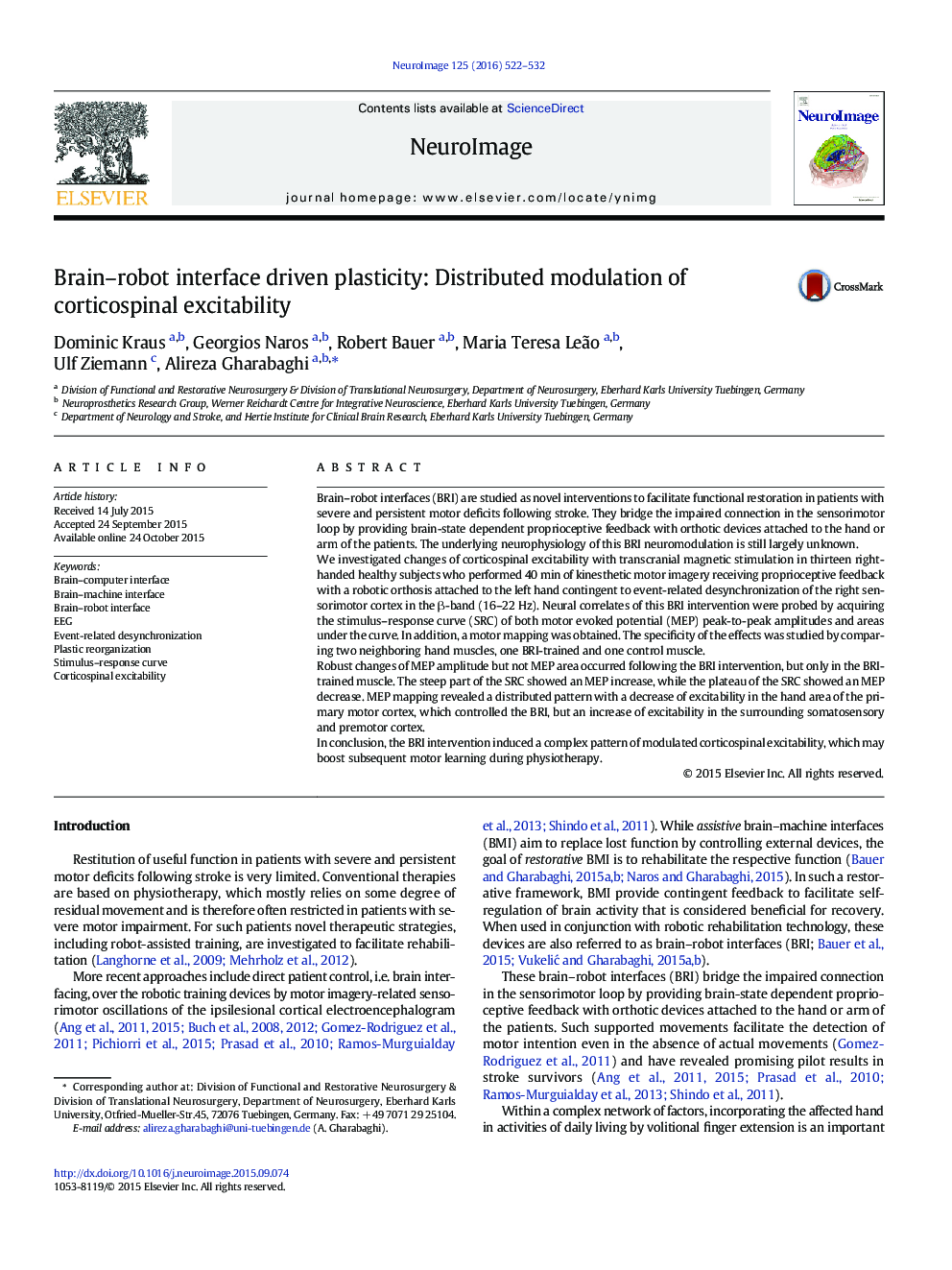| کد مقاله | کد نشریه | سال انتشار | مقاله انگلیسی | نسخه تمام متن |
|---|---|---|---|---|
| 6024133 | 1580883 | 2016 | 11 صفحه PDF | دانلود رایگان |

- BRI feedback of motor-imagery related sensorimotor β-band ERD induced robust and muscle-specific changes of corticospinal excitability.
- The steep part and the plateau of the TMS stimulus-response curve revealed increases and decreases of excitability, respectively.
- M1 and the surrounding somatosensory/premotor cortex revealed opposing effects with decreases and increases of excitability, respectively.
- These effects where related to modulated synchronization and not to the recruitment of additional neurons.
- The training induced changes of β-band ERD of individual participants correlated with increased corticospinal excitability.
Brain-robot interfaces (BRI) are studied as novel interventions to facilitate functional restoration in patients with severe and persistent motor deficits following stroke. They bridge the impaired connection in the sensorimotor loop by providing brain-state dependent proprioceptive feedback with orthotic devices attached to the hand or arm of the patients. The underlying neurophysiology of this BRI neuromodulation is still largely unknown.We investigated changes of corticospinal excitability with transcranial magnetic stimulation in thirteen right-handed healthy subjects who performed 40 min of kinesthetic motor imagery receiving proprioceptive feedback with a robotic orthosis attached to the left hand contingent to event-related desynchronization of the right sensorimotor cortex in the β-band (16-22 Hz). Neural correlates of this BRI intervention were probed by acquiring the stimulus-response curve (SRC) of both motor evoked potential (MEP) peak-to-peak amplitudes and areas under the curve. In addition, a motor mapping was obtained. The specificity of the effects was studied by comparing two neighboring hand muscles, one BRI-trained and one control muscle.Robust changes of MEP amplitude but not MEP area occurred following the BRI intervention, but only in the BRI-trained muscle. The steep part of the SRC showed an MEP increase, while the plateau of the SRC showed an MEP decrease. MEP mapping revealed a distributed pattern with a decrease of excitability in the hand area of the primary motor cortex, which controlled the BRI, but an increase of excitability in the surrounding somatosensory and premotor cortex.In conclusion, the BRI intervention induced a complex pattern of modulated corticospinal excitability, which may boost subsequent motor learning during physiotherapy.
Brain-robot interface feedback of motor-imagery related sensorimotor β-band desynchronization induced robust and muscle-specific changes of corticospinal excitability with opposing effects on the trained finger extension muscle with decreases (blue/turquoise) and increases (red/yellow) of excitability in the TMS motor map for the primary motor cortex and the surrounding somatosensory and premotor cortex, respectively. The green dot represents the 'hot spot', where the MEP stimulus response curve was acquired and resulted in opposing effects for the steep part and the plateau of the TMS stimulus-response curve with increases and decreases of excitability, respectively. The neurophysiological effects where related to modulated synchronization of the stimulated neuronal population and not to the recruitment of additional neurons. The training induced changes of β-band desynchronization in the somatosensory cortex of individual participants correlated with increased corticospinal excitability.72
Journal: NeuroImage - Volume 125, 15 January 2016, Pages 522-532